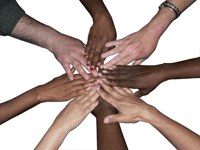At Mencap, we are striving to be a diverse organisation. We aim to offer our services and support to anybody with a learning disability and their families and carers. We are striving to be a diverse organisation because we know that we’re not reaching enough people from black and minority ethnic communities in England, Wales and Northern Ireland.
In HR diversity training we discussed the relationship between the diversity of our workforce and the diversity of our beneficiaries. A chicken and egg situation: the more minority ethnic staff you employ, the more people will find out about your services. But the more minority ethnic people that know about your services, the more likely you are to get minority ethnic applicants wanting to join the organisation. Suffice to say, there is no quick-fix solution.
For a while I have pondered whether this theory could be applied to our fundraising sector. Do we struggle to attract minority ethnic applicants because we don’t have many minority ethnic donors?
To answer this question we need to consider two others: Is fundraising an ethnically diverse profession and do ethnic minorities donate?
I searched the internet and found no statistic to show how ethnically diverse fundraising is, so I can only look at the people I work with both at Mencap and in the wider sector and I generally feel that we aren’t diverse. The majority of my colleagues at Mencap over the last six years have been white women. This, I have to state, is not a bad thing. A good fundraiser is passionate about the cause and hard-working and this has nothing to do with race or gender. Times are changing, with Paul Amadi taking over the role of chair of the Institute of Fundraising, but they are changing slowly. The PF 50 Most Influential is a reflection of this. I won’t labour this point, if anyone has any evidence please feel free to post.
So are our donors diverse? Again I struggled to find evidence. We know the age, gender and economic profile of the majority of our donors, but not the ethnicity. I once asked a member of the public if they would like to include their ethnicity on a complaint form, and they told me where to go. Finding out the ethnicity of our supporters is not something I could justify spending our fundraising resources on.
Fortunately, I was saved by Joe Saxton, who shared with me nfpSynergy’s Ethnic Minorities Charity Engagement Monitor, which will be realesed shortly. I’m not going to reel off any stats, but instead give my interpretation of the findings.
Losing out on gift aid
It is clear from the report that minority ethnic communities give both monetary donations and their time. Donations are mostly in the form of coins and notes given to collectors. There is also strong evidence to show that ethnic minorities have a healthy fear/distrust of direct mail and don’t like the thought of their details being held on charity databases. These factors together mean that little or no gift aid is claimed.
The research took place at a time of major natural disasters in Bangladesh, India and China and a large proportion of the donations of cash and goods from the Asian communities (for the purpose of this blog, Asian refers to Bangladeshi, Indian and Pakistani communities) were in response to these disasters. Disaster relief, international development and children’s charities came top of the list in causes supported. In the Asian community, the report suggests, either very few donations are given to religious organisation or the donors don’t see their place of worship as a charity. Religion plays a much stronger role in influencing the person to give or guides their choice of charity.
In Caribbean and African communities the trend of giving cash continues, but to a lesser extent than with Asian responders. In contrast volunteering in the community is high, with many cash donations given at social charitable events. Favoured causes mirror those of the Asian community, with religion, friends, family and community playing a large role in causes are supported.
The report also touches on how black and ethnic minorities access charity services. Asian people, especially Indians (as above) access information services primarily through the phone and then online. Caribbean and African responders had worrying low levels of accessing charity services.
Diversity in fundraising is necessary
So back to my original question, is diversity in fundraising necessary? I say yes. The fear of giving personal details is leading to little gift aid and a lack of understand of how donations are making a difference. We aren’t communicating with ethnic communities in a way they appreciate, leading to low levels of knowledge about services on offer.
But practically how could diversity make a difference to help us reach new supporters? Two ways spring to mind. The Asian community will give at times of disaster and are responsive to communicating by telephone. A well-timed call from an Asian telephone fundraiser to an Asian supporter could give the opportunity to get a tax-effective donation and offer the opportunity to allow the donor to pick when and how they would be happy to be contacted.
Community fundraising springs to mind for reaching the Caribbean and African communities, who give most with and because of their community. Again, the opportunity to explain the benefits of gift aid and the option of ongoing communication in a preferable way could be raised.
Now I am not saying that Asian people will only give to other Asians and black people won’t listen to white people, but according to nfpSynergy, we are not meeting the needs of ethnic minorities in service provision, or as supporters.









